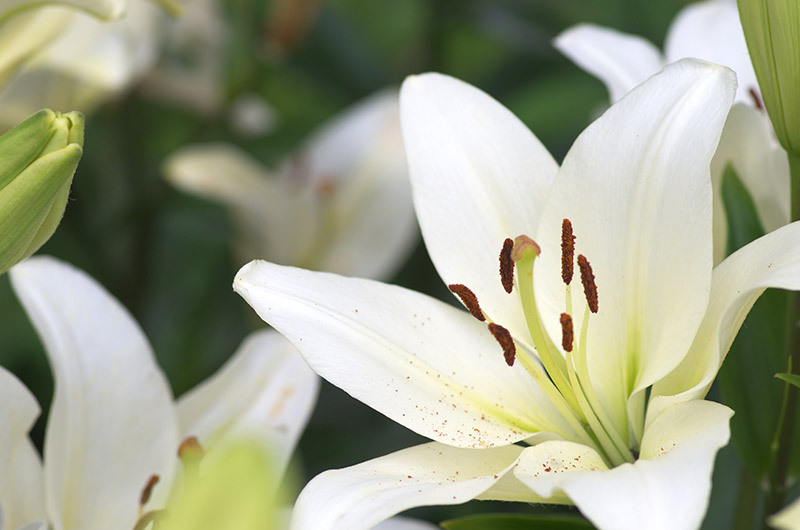Guide to Nurturing Your Cut Flowers for Longer Enjoyment
Posted on 27/08/2025
Guide to Nurturing Your Cut Flowers for Longer Enjoyment
Bringing a bouquet of vibrant blooms into your home is a fantastic way to brighten your space and elevate your mood. However, cut flowers have a reputation for wilting sooner than we'd like. The good news is, with the right care, you can dramatically extend the life of your cut flowers, savoring their beauty for days - or even weeks - longer than usual. In this comprehensive guide, we'll provide scientifically-backed insights and practical tips for nurturing your beautiful bouquets, securing longer-lasting enjoyment.
Understanding the Lifecycle of Cut Flowers
Before diving into preservation techniques, it's vital to understand why cut flowers fade. When a bloom is removed from its plant, it loses its primary water and nutrient source. Cellular activity inside the stem rapidly changes, with air bubbles and bacteria entering the vascular system, impeding water uptake. By addressing these changes with proper flower care practices, you can help your bouquet remain fresh and beautiful for longer.

Essential Steps for Prolonging Cut Flower Freshness
1. Choose the Freshest Flowers
- Inspect before Buying: Look for flowers with tight buds (unless the variety is best enjoyed fully open), vibrant leaves, and firm stems. Avoid any with wilting petals or yellowing foliage.
- Buy Local When Possible: Locally grown flowers spend less time in transit, resulting in longer vase life at home.
2. Immediate Care: From Store to Vase
- Keep Cool: Heat accelerates wilting. Transport cut flowers home in a shaded, cool environment.
- Water Soak: Upon arrival, place stems in room temperature water for at least 10-20 minutes while preparing your vase.
3. Preparing Your Vase
- Cleanliness is Key: Bacteria can quickly colonize vases and stems, shortening lifespan. Scrub your vase with hot, soapy water and rinse thoroughly before use.
- Use the Right Size: Choose a vase that adequately supports stem length and bouquet fullness.
Proper Cutting Techniques for Longevity
Applying correct cutting methods when arranging your cut flowers is foundational for longer enjoyment. Here's how to do it right:
- Cut at an Angle: Use sharp scissors or garden shears to cut stems at a 45-degree angle. This increases water absorption and keeps stems from sealing to the bottom of the vase.
- Trim Leaves Below Water Line: Remove foliage that will sit below the water's surface, as submerged leaves encourage rot and bacteria growth.
- Re-cut Every Few Days: Every 2-3 days, trim 1-2 centimeters from the bottom of each stem to ensure optimal water uptake.
Water and Nutrition: The Lifeblood of Cut Flowers
Fresh, clean water is the most important factor in prolonging your bouquet's life. But did you know floral nutrition plays a crucial role as well?
Water Quality & Temperature
- Room Temperature Water: Fill your vase with lukewarm (not hot) water, which is absorbed more quickly than cold.
- Change Water Regularly: Replace vase water every 1-2 days to prevent bacterial build-up and maintain freshness.
- Deep vs Shallow Water: Most cut flowers prefer vases filled halfway. Woody-stemmed varieties (like roses) may benefit from deeper water.
Floral Food and DIY Alternatives
- Commercial Flower Food: Most bouquets come with pre-mixed sachets containing a balance of sugars (food), acidifiers (pH control), and antibacterial agents.
- Homemade Flower Preservatives: In a pinch, create your own by adding one teaspoon sugar, one teaspoon lemon juice or vinegar, and a few drops of household bleach per liter of water.
Important: Avoid copper pennies, aspirin, or soda; these have uneven results and could harm certain flowers.
Optimal Display Conditions for Extended Enjoyment
Where and how you display your cut flowers can significantly influence their longevity. Follow these guidelines for the best results:
- Avoid Direct Sunlight: Exposure to intense sunlight accelerates fading and petal drop.
- Keep Away from Heat Sources: Radiators, TVs, or other hot appliances dry out blooms rapidly.
- No Drafts or Air Conditioning: Fast-moving or cold air dehydrates petals and leaves.
- Distance from Ripening Fruit: Many fresh fruits emit ethylene gas, which triggers flower aging and petal drop.
Troubleshooting Common Problems
Even with diligent care, sometimes your cut flowers may wilt or discolor prematurely. Here's how to address common pitfalls:
- Wilting Stems: Air blockage in stems is a frequent culprit. Re-cut under running water and place in fresh water.
- Murky Water: Indicates bacteria growth. Remove flowers, wash vase, replace with clean water and preservative.
- Petal Drop: Can be due to either ethylene exposure or too warm an environment. Relocate your arrangement.
Special Considerations for Different Flower Varieties
Not all cut flower types have identical requirements. Here are a few specific guidelines for popular choices:
Roses
- Remove thorns and leaves that may fall into water, as these invite bacteria.
- If heads droop, submerge the entire stem overnight in cool water to rejuvenate.
Lilies
- Remove pollen-laden stamens to prevent staining and prolong the life of petals.
- Handle with care; bruised petals turn brown quickly.
Tulips
- Place tulips in tall, straight-sided vessels for support as they continue to grow after cutting.
- Keep them away from sources of heat and direct sunlight for best results.
Hydrangeas
- Their thick, woody stems benefit from a vertical slit to improve hydration.
- Mist the flower heads daily; hydrangeas absorb water through their petals too.
Daffodils
- Daffodils excrete a sap toxic to most other flowers. For mixed arrangements, soak daffodils by themselves for a few hours first, rinse, then combine.
Creative Ways to Repurpose or Revitalize Wilted Flowers
Sometimes, despite your best efforts, your blooms begin to fade. Don't discard them just yet! Try these innovative ways to enjoy your flowers even longer:
- Dry or Press: Air-dry roses, lavender, or eucalyptus for dried bouquets or potpourri.
- Create Potpourri: Remove petals and mix with essential oils for a fragrant sachet.
- Floral Ice Cubes: Freeze edible petals in ice trays for decorative drinks.
- Art and Crafts: Press flowers for scrapbooking, cards, or wall art.
Bonus Tips for Even Longer Enjoyment
- Refrigerate overnight: Just like florists, placing your vase in the fridge overnight can extend the life of most cut flowers.
- Separate Strongly Scented Flowers: Some fragrant blooms age faster and can affect nearby flowers. Keep highly scented bouquets separate for more prolonged enjoyment.
- Monitor the Condition Daily: Remove any fading stems promptly to prevent premature aging of the rest.

Frequently Asked Questions About Cut Flower Preservation
-
How long do cut flowers typically last?
With proper care, most cut flowers last 7-10 days, but certain types (such as chrysanthemums or carnations) can thrive for up to two weeks or longer. -
Can I use sugar alone as flower food?
Sugar offers nourishment but lacks antibacterial and acidifying elements. For best results, use a balanced preservative or DIY mix as outlined above. -
Should I remove plastic wrapping immediately after purchase?
Yes, plastic wrapping restricts airflow and promotes moisture buildup. Remove it as soon as you get home. -
Is it safe to use tap water?
In most cases, yes. If your water is heavily chlorinated or softened, filtered or distilled water is preferable.
Conclusion: Enjoy Your Cut Flowers Longer
Nurturing your cut flowers for longer enjoyment is both an art and a science. By choosing fresh blooms, preparing stems and vases properly, vigilantly refreshing water, and optimizing display conditions, you can celebrate the beauty of your flowers for as long as possible. Whether you're pampering a bouquet for a special occasion or simply bringing daily color to your home, these expert tips will help you enjoy lasting beauty and fragrant delight from every arrangement.
Ready for a longer-lasting bouquet? Start today with these proven tips and transform your cut flowers into pride-of-place masterpieces you'll cherish every day!
Latest Posts
Guide to Nurturing Your Cut Flowers for Longer Enjoyment
Orchid Care Techniques for Vibrant Plant Health
Unravel the enchanting facts about sunflowers you won't believe






